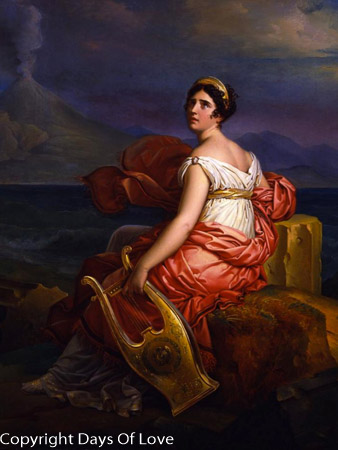

Partner Juliette Récamier
Queer Places:
102 Rue de Grenelle, 75007 Paris, France
Château de Coppet, Rue de la gare, 2, 1296 Coppet, Svizzera
 Anne
Louise Germaine de Staël-Holstein (née Necker; 22 April 1766 – 14 July 1817),
commonly known as Madame de Staël, was a French woman of letters of Swiss
origin whose lifetime overlapped with the events of the French Revolution and
the Napoleonic era. For many years she lived as an exile under the Reign of
Terror and under Napoleonic persecution. Known as a witty and brilliant
conversationalist, often dressed in flashy and revealing outfits, she
participated actively in the political and intellectual life of her times. She
was present at the first opening of the Estates General and at the Declaration
of the Rights of Man and of the Citizen,[1]
and witnessed the departure of the royal family from Versailles. Her
intellectual collaboration with Benjamin Constant between 1795 and 1811 made
them one of the most celebrated intellectual couples of their time. They
discovered sooner than others the tyrannical character and designs of
Napoleon.[2]
Anne
Louise Germaine de Staël-Holstein (née Necker; 22 April 1766 – 14 July 1817),
commonly known as Madame de Staël, was a French woman of letters of Swiss
origin whose lifetime overlapped with the events of the French Revolution and
the Napoleonic era. For many years she lived as an exile under the Reign of
Terror and under Napoleonic persecution. Known as a witty and brilliant
conversationalist, often dressed in flashy and revealing outfits, she
participated actively in the political and intellectual life of her times. She
was present at the first opening of the Estates General and at the Declaration
of the Rights of Man and of the Citizen,[1]
and witnessed the departure of the royal family from Versailles. Her
intellectual collaboration with Benjamin Constant between 1795 and 1811 made
them one of the most celebrated intellectual couples of their time. They
discovered sooner than others the tyrannical character and designs of
Napoleon.[2]
In 1807, Madame de Staël (Germaine Necker) championed Rome’s female literary heritage in her extraordinarily popular novel, Corinne, or Italy. A novelist, feminist, and political thinker, she arrived in Italy with her children in 1804, a refugee from Napoleon’s France. In Rome, she attended the salons of Angelika Kauffmann and became a member of the Arcadian Academy.
In 1814 one of de Staël's contemporaries observed that "there are three great powers struggling against Napoleon for the soul of Europe: England, Russia, and Madame de Staël".[3] Her works, both novels and travel literature, with emphasis on passion, individuality and oppositional politics made their mark on European Romanticism. Personal freedom was evidently as important to her as abstract political liberties.[4]
Germaine lived in Saint-Ouen near Montmartre, on her father's estate and became friends with the beautiful and rich Juliette Récamier.
My published books: